*NURSING > EXAM > NUR 155 Test 2 (Crisis 2 NCLEX), FOUNDATIONS OF NURSING Comprehensive Exam Questions & Answers (With (All)
NUR 155 Test 2 (Crisis 2 NCLEX), FOUNDATIONS OF NURSING Comprehensive Exam Questions & Answers (With Rationales)
Document Content and Description Below
NUR 155 Test 2 (Crisis 2 NCLEX), FOUNDATIONS OF NURSING Comprehensive Exam Questions & Answers (With Rationales)-168. The nurse has just reassessed the condition of a postoperative client who was admi... tted 1 hour ago to the surgical unit. The nurse plans to monitor which parameter most carefully during the next hour? 1. Urinary output of 20 mL/hour 2. Temperature of 37.6 °C (99.6 °F) 3. Blood pressure of 100/70 mm Hg 4. Serous drainage on the surgical dressing - 1 Rationale: Urine output should be maintained at a minimum of 30 mL/hour for an adult. An output of less than 30 mL for 2 consecutive hours should be reported to the health care provider. A temperature higher than 37.7 °C (100 °F) or lower than 36.1 °C (97 °F) and a falling systolic blood pressure, lower than 90 mm Hg, are usually considered reportable immediately. The client's preoperative or baseline blood pressure is used to make informed postoperative comparisons. Moderate or light serous drainage from the surgical site is considered normal. 169. The nurse is teaching a client about coughing and deep-breathing techniques to prevent postoperative complications. Which statement is most appropriate for the nurse to make to the client at this time as it relates to these techniques? 1. "Use of an incentive spirometer will help prevent pneumonia." 2. "Close monitoring of your oxygen saturation will detect hypoxemia." 3. "Administration of intravenous fluids will prevent or treat fluid imbalance." 4. "Early ambulation and administration of blood thinners will prevent pulmonary embolism." - 1 Rationale: Postoperative respiratory problems are atelectasis, pneumonia, and pulmonary emboli. Pneumonia is the inflammation of lung tissue that causes productive cough, dyspnea, and lung crackles and can be caused by retained pulmonary secretions. Use of an incentive spirometer helps to prevent pneumonia and atelectasis. Hypoxemia is an inadequate concentration of oxygen in arterial blood. While close monitoring of the oxygen saturation will help to detect hypoxemia, monitoring is not directly related to coughing and deep-breathing techniques. Fluid imbalance can be a deficit or excess related to fluid loss or overload, and surgical clients are often given intravenous fluids to prevent a deficit; however, this is not related to coughing and deep breathing. Pulmonary embolus occurs as a result of a blockage of the pulmonary artery that disrupts blood flow to 1 or more lobes of the lung; this is usually due to clot formation. Early ambulation and administration of blood thinners helps to prevent this complication; however, it is not related to coughing and deep-breathing techniques. 170. The nurse is creating a plan of care for a client scheduled for surgery. The nurse should include which activity in the nursing care plan for the client on the day of surgery? 1. Avoid oral hygiene and rinsing with mouthwash. 2. Verify that the client has not eaten for the last 24 hours. 3. Have the client void immediately before going into surgery. 4. Report immediately any slight increase in blood pressure or pulse. - 3 Rationale: The nurse would assist the client to void immediately before surgery so that the bladder will be empty. Oral hygiene is allowed, but the client should not swallow any water. The client usually has a restriction of food and fluids for 6 to 8 hours (or longer as prescribed) before surgery instead of 24 hours. A slight increase in blood pressure and pulse is common during the preoperative period and is usually the result of anxiety. 171. A client with a gastric ulcer is scheduled for surgery. The client cannot sign the operative consent form because of sedation from opioid analgesics that have been administered. The nurse should take which most appropriate action in the care of this client? 1. Obtain a court order for the surgery. 2. Have the charge nurse sign the informed consent immediately. 3. Send the client to surgery without the consent form being signed. 4. Obtain a telephone consent from a family member, following agency policy. - 4 Rationale: Every effort should be made to obtain permission from a responsible family member to perform surgery if the client is unable to sign the consent form. A telephone consent must be witnessed by 2 persons who hear the family member's oral consent. The 2 witnesses then sign the consent with the name of the family member, noting that an oral consent was obtained. Consent is not informed if it is obtained from a client who is confused, unconscious, mentally incompetent, or under the influence of sedatives. In an emergency, a client may be unable to sign and family members may not be available. In this situation, a health care provider is permitted legally to perform surgery without consent, but the data in the question do not indicate an emergency. Options 1, 2, and 3 are not appropriate in this situation. Also, agency policies regarding informed consent should always be followed. 172. A preoperative client expresses anxiety to the nurse about upcoming surgery. Which response by the nurse is most likely to stimulate further discussion between the client and the nurse? 1. "If it's any help, everyone is nervous before surgery." 2. "I will be happy to explain the entire surgical procedure to you." 3. "Can you share with me what you've been told about your surgery?" 4. "Let me tell you about the care you'll receive after surgery and the amount of pain you can anticipate." - 3 Rationale: Explanations should begin with the information that the client knows. By providing the client with individualized explanations of care and procedures, the nurse can assist the client in handling anxiety and fear for a smooth preoperative experience. Clients who are calm and emotionally prepared for surgery withstand anesthesia better and experience fewer postoperative complications. Option 1 does not focus on the client's anxiety. Explaining the entire surgical procedure may increase the client's anxiety. Option 4 avoids the client's anxiety and is focused on postoperative care. 173. The nurse is conducting preoperative teaching with a client about the use of an incentive spirometer. The nurse should include which piece of information in discussions with the client? 1. Inhale as rapidly as possible. 2. Keep a loose seal between the lips and the mouthpiece. 3. After maximum inspiration, hold the breath for 15 seconds and exhale. 4. The best results are achieved when sitting up or with the head of the bed elevated 45 to 90 degrees. - 4 Rationale: For optimal lung expansion with the incentive spirometer, the client should assume the semi-Fowler's or high Fowler's position. The mouthpiece should be covered completely and tightly while the client inhales slowly, with a constant flow through the unit. The breath should be held for 5 seconds before exhaling slowly. 174. The nurse has conducted preoperative teaching for a client scheduled for surgery in 1 week. The client has a history of arthritis and has been taking acetylsalicylic acid. The nurse determines that the client needs additional teaching if the client makes which statement? 1. "Aspirin can cause bleeding after surgery." 2. "Aspirin can cause my ability to clot blood to be abnormal." 3. "I need to continue to take the aspirin until the day of surgery." 4. "I need to check with my health care provider about the need to stop the aspirin before the scheduled surgery." - 3 Rationale: Antiplatelets alter normal clotting factors and increase the risk of bleeding after surgery. Aspirin has properties that can alter platelet aggregation and should be discontinued at least 48 hours before surgery. However, the client should always check with his or her health care provider regarding when to stop taking the aspirin when a surgical procedure is scheduled. Options 1, 2, and 4 are accurate client statements. 175. The nurse assesses a client's surgical incision for signs of infection. Which finding by the nurse would be interpreted as a normal finding at the surgical site? 1. Red, hard skin 2. Serous drainage 3. Purulent drainage 4. Warm, tender skin - 2 Rationale: Serous drainage is an expected finding at a surgical site. The other options indicate signs of wound infection. Signs and symptoms of infection include warm, red, and tender skin around the incision. Wound infection usually appears 3 to 6 days after surgery. The client also may have a fever and chills. Purulent material may exit from drains or from separated wound edges. Infection may be caused by poor aseptic technique or a contaminated wound before surgical exploration; existing client conditions such as diabetes mellitus or immunocompromise may place the client at risk. 176. The nurse is monitoring the status of a postoperative client in the immediate postoperative period. The nurse would become most concerned with which sign that could indicate an evolving complication? 1. Increasing restlessness 2. A pulse of 86 beats/minute 3. Blood pressure of 110/70 mm Hg 4. Hypoactive bowel sounds in all 4 quadrants - 1 Rationale: Increasing restlessness is a sign that requires continuous and close monitoring because it could indicate a potential complication, such as hemorrhage, shock, or pulmonary embolism. A blood pressure of 110/70 mm Hg with a pulse of 86 beats/minute is within normal limits. Hypoactive bowel sounds heard in all 4 quadrants are a normal occurrence in the immediate postoperative period. 177. A client who has had abdominal surgery complains of feeling as though "something gave way" in the incisional site. The nurse removes the dressing and notes the presence of a loop of bowel protruding through the incision. Which interventions should the nurse take? Select all that apply. 1. Contact the surgeon. 2. Instruct the client to remain quiet. 3. Prepare the client for wound closure. 4. Document the findings and actions taken. 5. Place a sterile saline dressing and ice packs over the wound. 6. Place the client in a supine position without a pillow under the head. - 1, 2, 3, 4 Rationale: Wound dehiscence is the separation of the wound edges. Wound evisceration is protrusion of the internal organs through an incision. If wound dehiscence or evisceration occurs, the nurse should call for help, stay with the client, and ask another nurse to contact the surgeon and obtain needed supplies to care for the client. The nurse places the client in a low Fowler's position, and the client is kept quiet and instructed not to cough. Protruding organs are covered with a sterile saline dressing. Ice is not applied because of its vasoconstrictive effect. The treatment for evisceration is usually immediate wound closure under local or general anesthesia. The nurse also documents the findings and actions taken. 178. A client who has undergone preadmission testing has had blood drawn for serum laboratory studies, including a complete blood count, coagulation studies, and electrolytes and creatinine levels. Which laboratory result should be reported to the surgeon's office by the nurse, knowing that it could cause surgery to be postponed? 1. Hemoglobin, 8.0 g/dL (80 mmol/L) 2. Sodium, 145 mEq/L (145 mmol/L) 3. Serum creatinine, 0.8 mg/dL (70.6 μmol/L) 4. Platelets, 210,000 cells/mm3 (210 × 103/μL/210 × 109/L) - 1 Rationale: Routine screening tests include a complete blood count, serum electrolyte analysis, coagulation studies, and a serum creatinine test. The complete blood count includes the hemoglobin analysis. All of these values are within normal range except for hemoglobin. If a client has a low hemoglobin level, the surgery likely could be postponed by the surgeon. [Show More]
Last updated: 1 week ago
Preview 1 out of 45 pages

Loading document previews ...
Buy this document to get the full access instantly
Instant Download Access after purchase
Add to cartInstant download
We Accept:

Reviews( 0 )
$13.50
Document information
Connected school, study & course
About the document
Uploaded On
Jun 24, 2024
Number of pages
45
Written in
Additional information
This document has been written for:
Uploaded
Jun 24, 2024
Downloads
0
Views
5






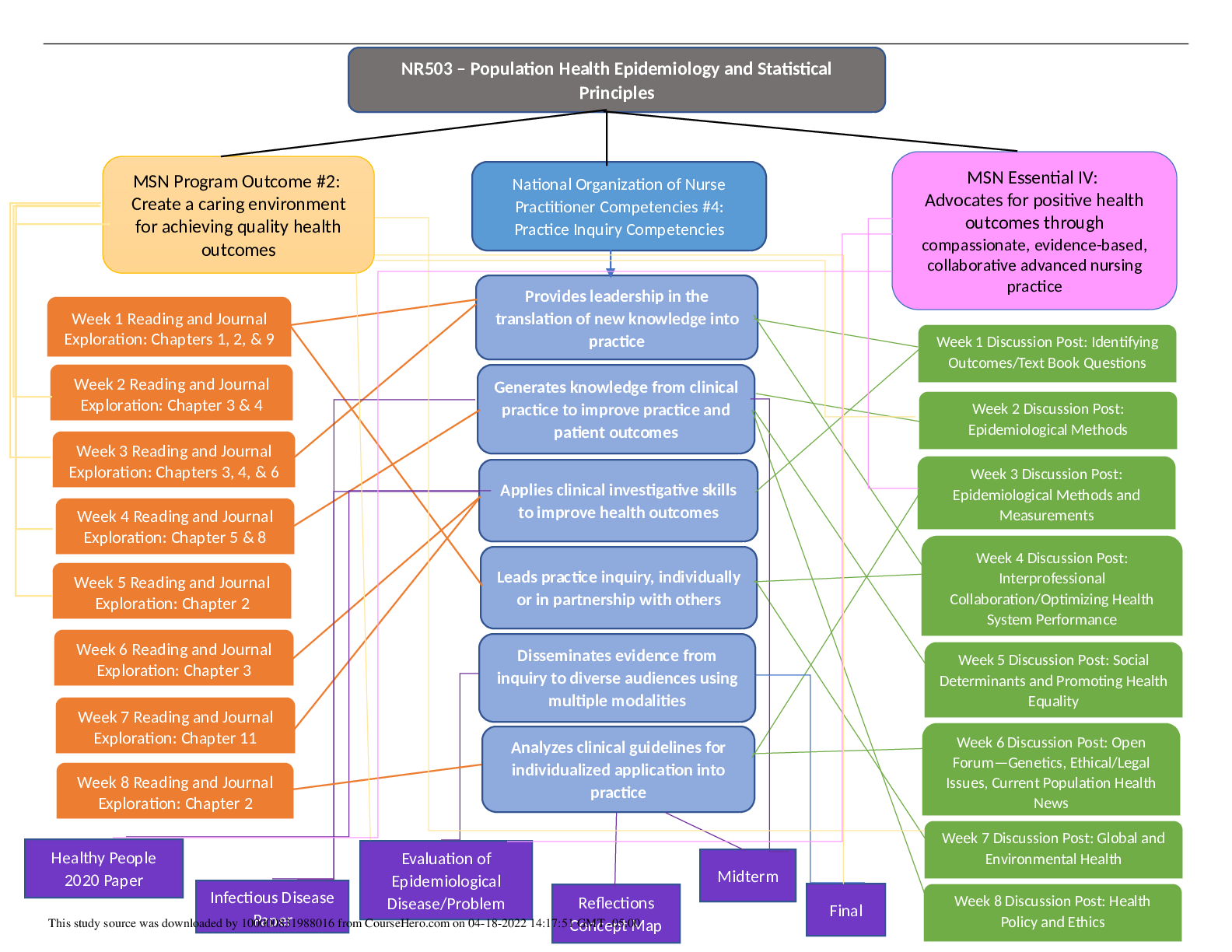

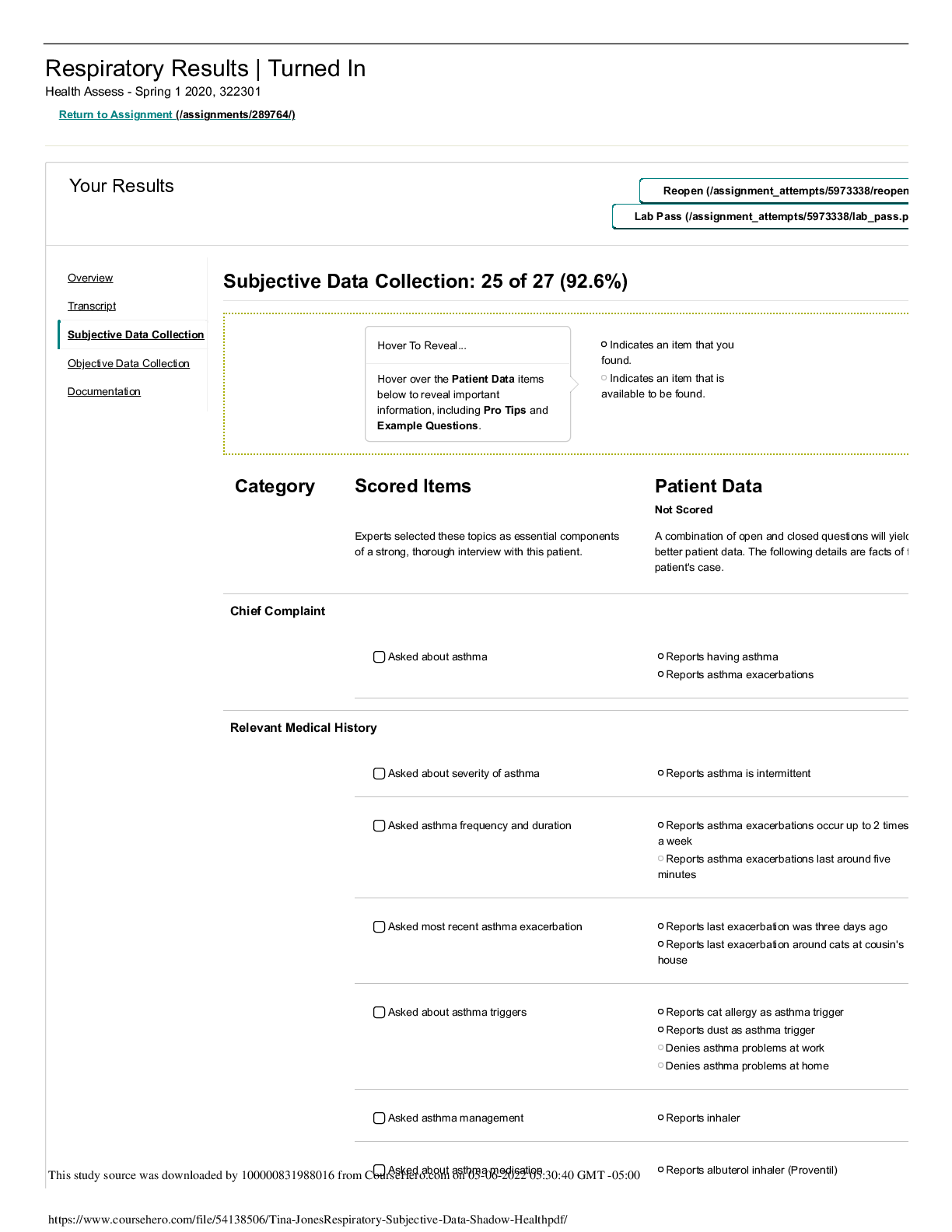
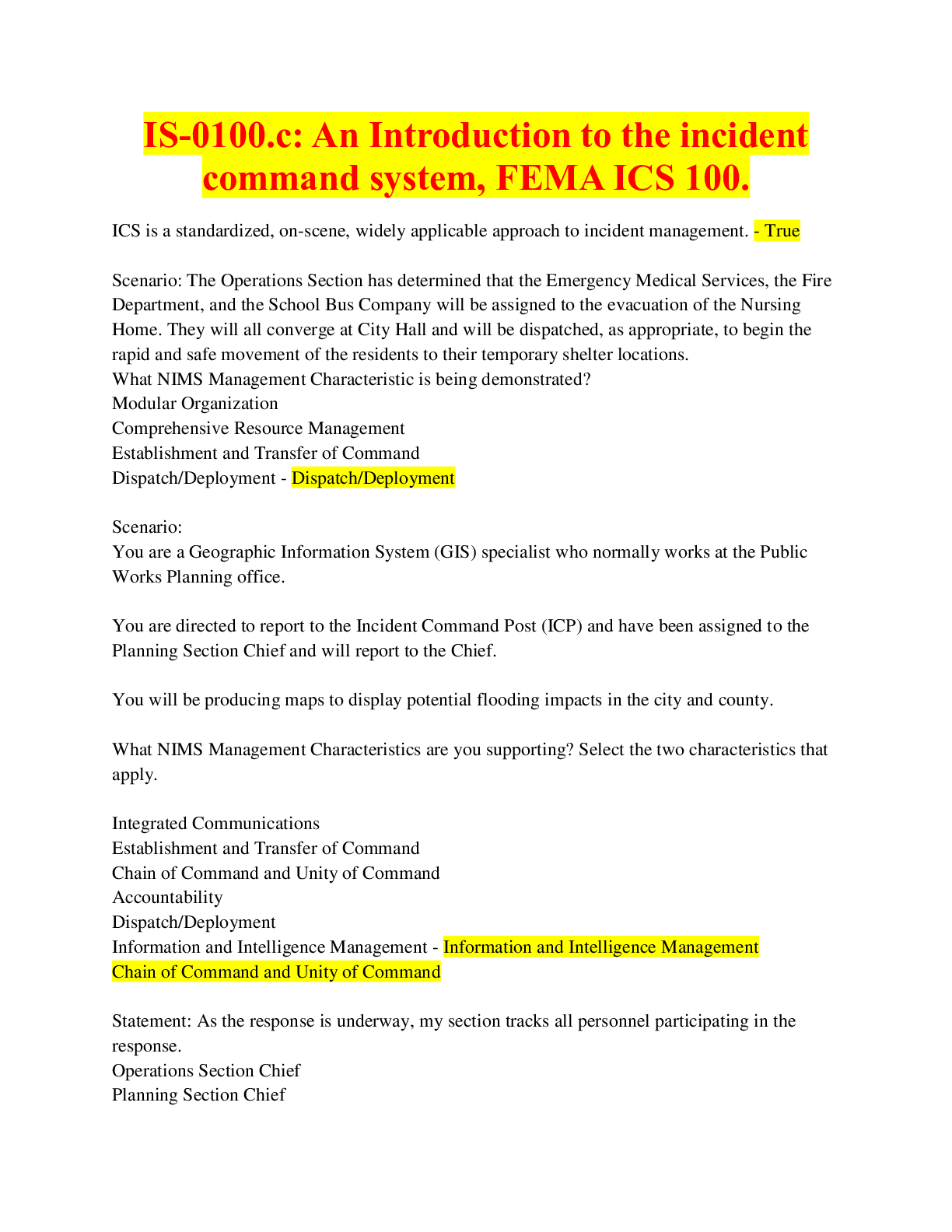



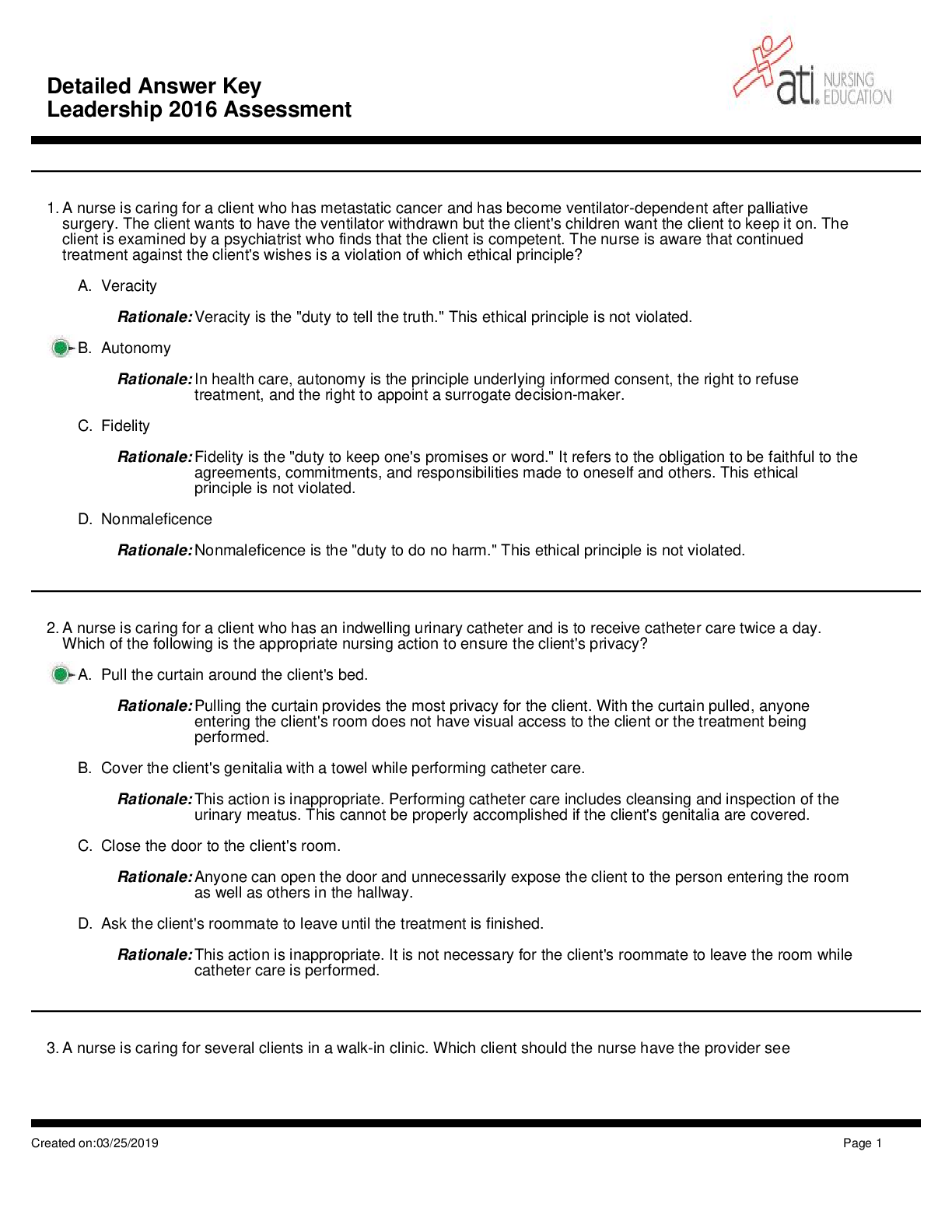
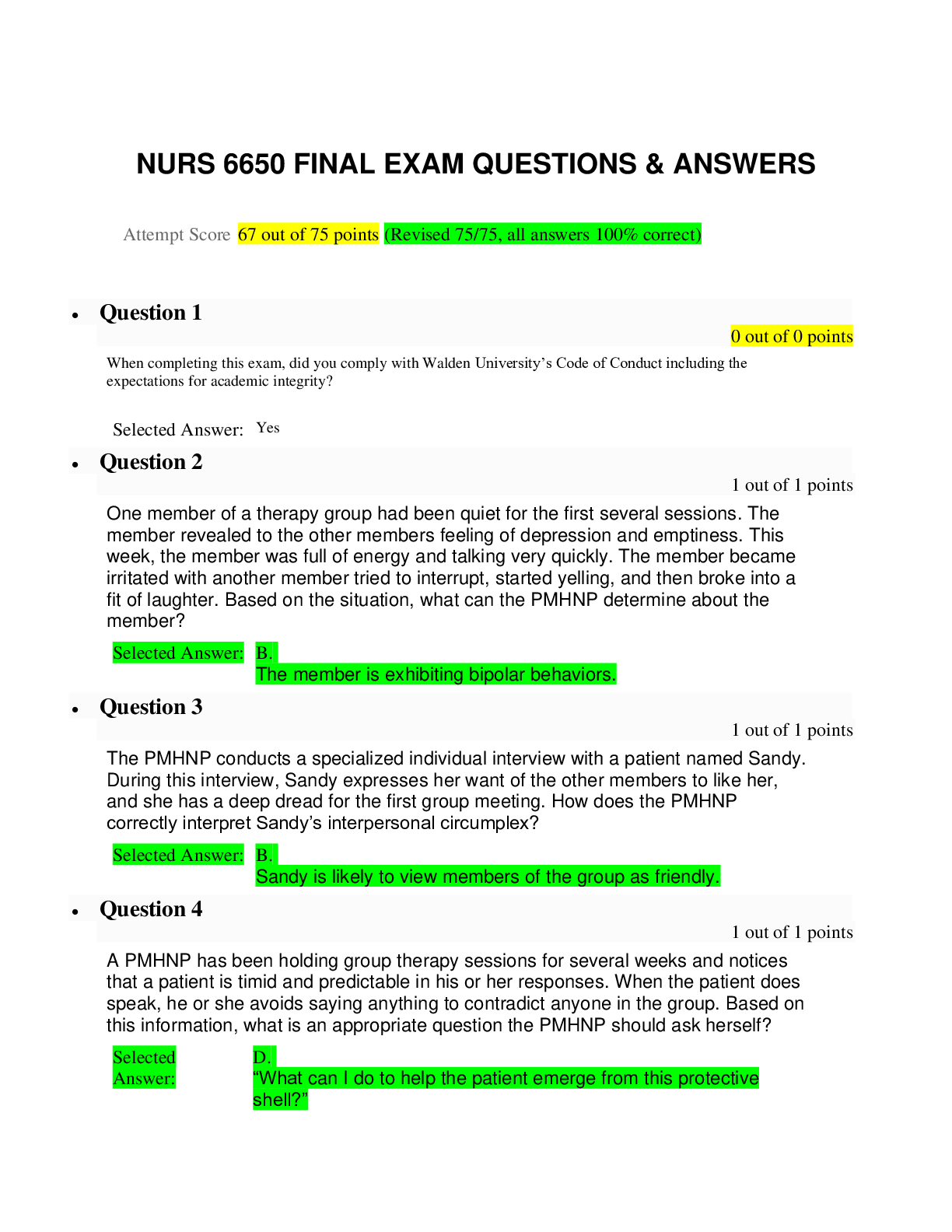
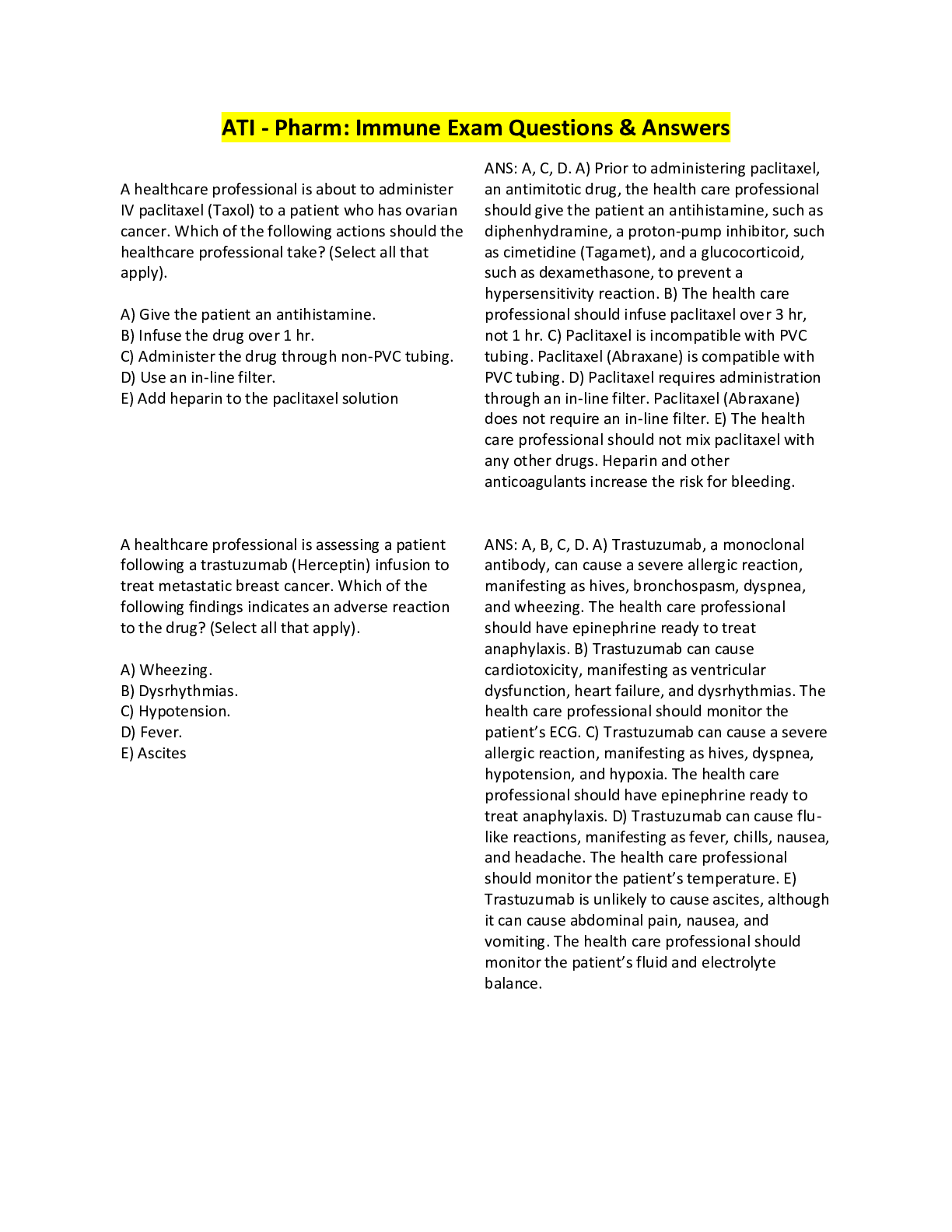
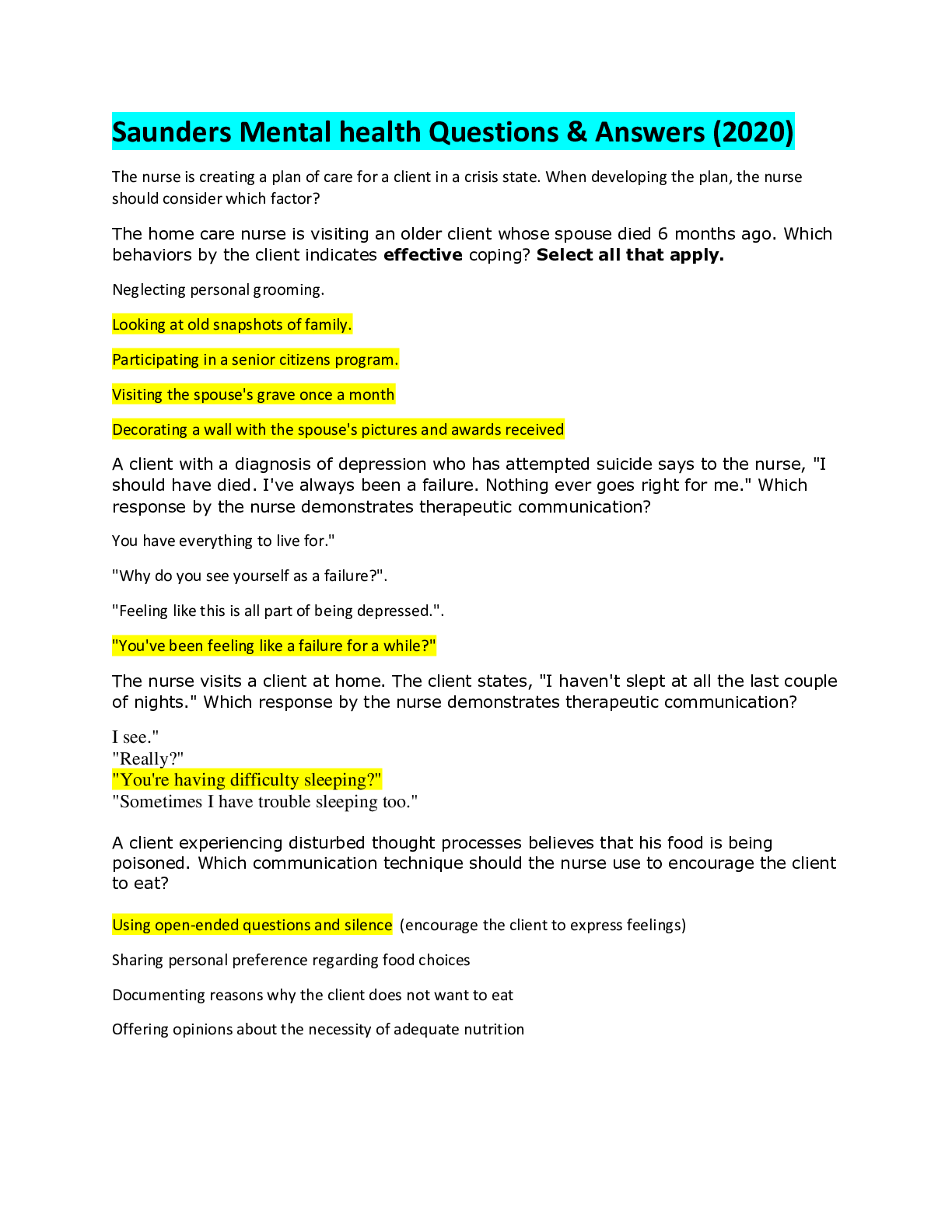
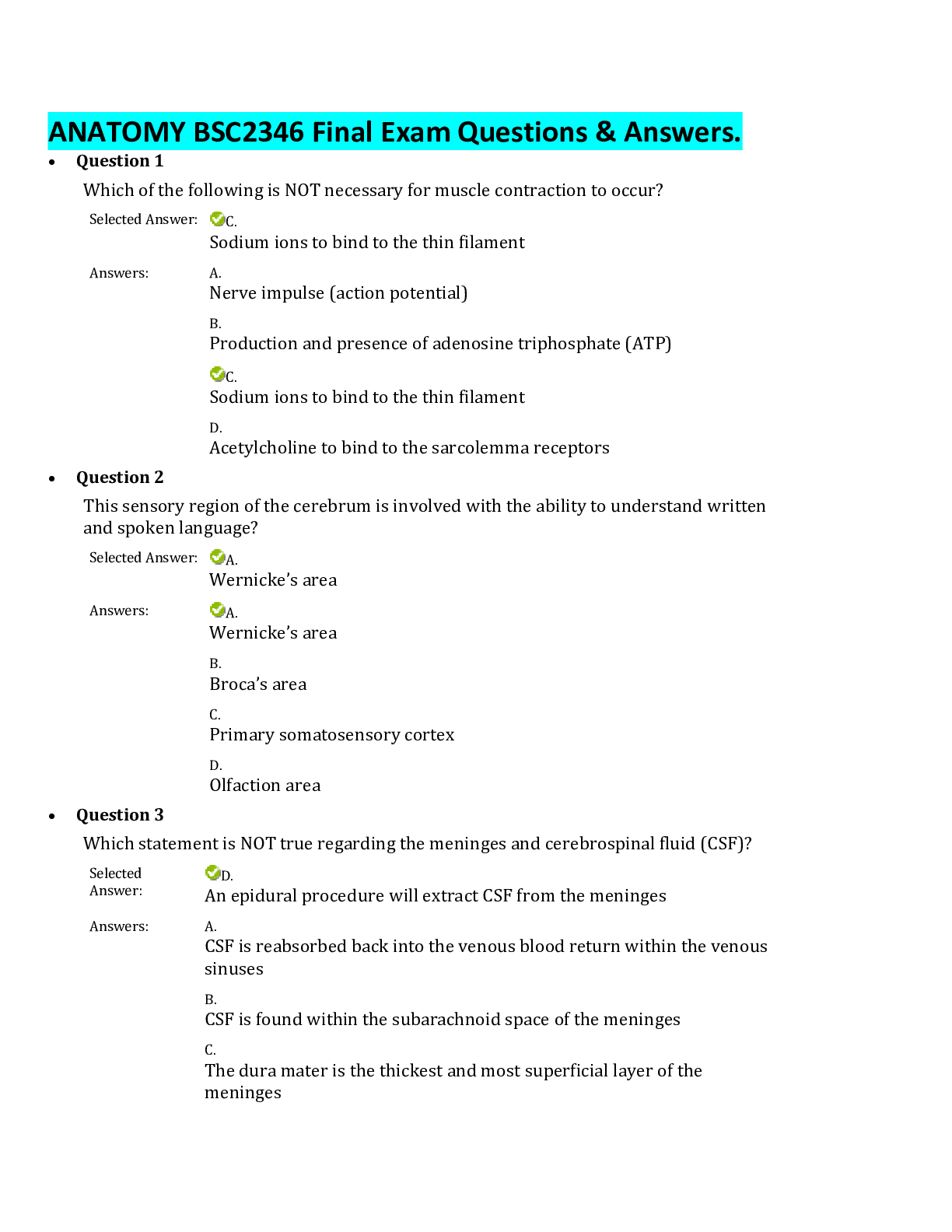

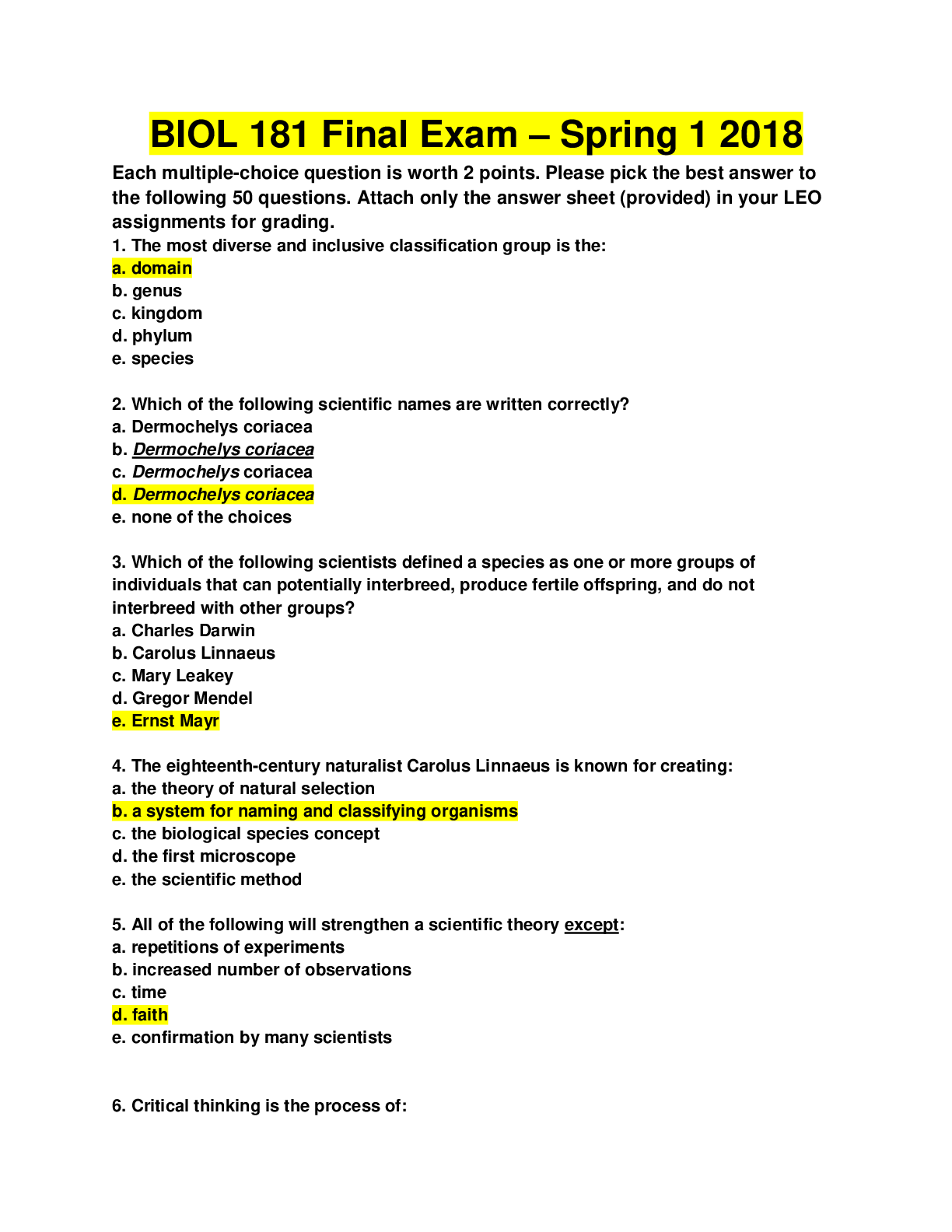
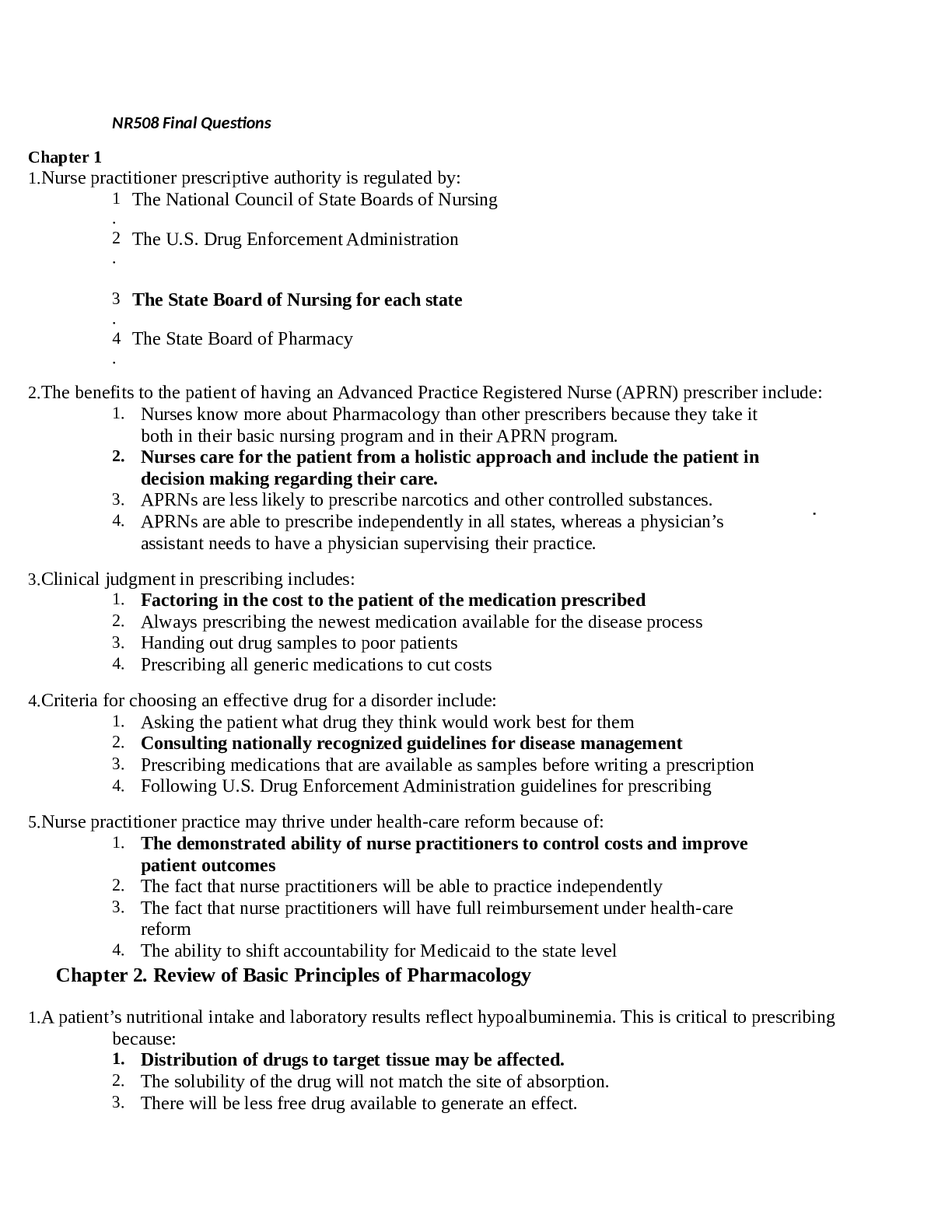

.png)

.png)

